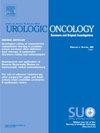FACTORS ASSOCIATED WITH PROSTATE CANCER SCREENING AMONG HISPANIC MEN: RESULTS FROM HISPANIC COMMUNITY HEALTH STUDY/STUDY OF LATINOS (HCHS/SOL)
IF 2.4
3区 医学
Q3 ONCOLOGY
Urologic Oncology-seminars and Original Investigations
Pub Date : 2025-03-01
DOI:10.1016/j.urolonc.2024.12.029
引用次数: 0
Abstract
Introduction
Known disparities exist in prostate cancer (PCa) treatment and outcome among Hispanic men. Hispanic men are significantly more likely to present with more advanced prostate cancer than non-Hispanic whites. Unequal access to early prostate cancer detection may result in higher rates of prostate cancer diagnoses at an advanced stage. Currently, little is known regarding the pattern of prostate cancer screening among Hispanic men. We aimed to determine the prostate cancer screening rate among Hispanic men and identify sociodemographic, cultural, psychosocial, medical, and healthcare access predictors associated with prostate cancer screening.
Methods
The Hispanic Community Health Study/Study of Latinos (HCHS/SOL) is a prospective, population-based multicenter observational study of Hispanic adults recruited from four US metropolitan areas (Bronx, NY; Miami, FL; San Diego, CA; Chicago, IL). We included Hispanic men 40+ years who participated in the study between 2014-2017. Our primary outcome was self-reported receipt of a PSA blood test. We excluded those with a prior prostate cancer diagnosis or a missing value for the outcome variable. All analyses were stratified by age categories (ages 40-54, 55-69, and 70+) and incorporated weights for sampling, stratification, and clustering to account for the HCHS/SOL complex survey design. Associations between participant characteristics and PSA screening rates were examined using t-tests and chi-squared tests. Weighted logistic regression models were used to examine the rates of PSA screening along with odds of having a PSA test given demographic, cultural, psychosocial, medical, and healthcare utilization factors.
Results
Our cohort included 3,484 diverse Hispanic men (Table 1) whose PSA screening rates were analyzed by race/nationality (Figure 1). PSA screening increased with age (40-54 years: 20%, 55-69 years: 46%, and 70+ years: 56%, p<0.001). Black Hispanic men have the lowest odds of screening (OR 0.24 95%CI: 0.07-0.86, p=0.028 for ages 40-54 and OR 0.31 95%CI: 0.11-0.91, p=0.033 for ages 55-69). Cuban men had the lowest odds of screening (OR 0.41 for ages 55-69 and OR 0.32 for ages 70+). For men aged 40-54, lower family cohesion, lower chronic stress, and not having a primary doctor predicted lack of PSA screening. For men aged 55-69, lower BMI, low social support, not having a personal doctor, and remote check-up predicted lack of PSA screening. For men aged 70+, odds of screening decreased with low education attainment and not having a personal doctor.
Conclusions
Among Hispanic men, a low rate of guideline-appropriate PSA screening and significant heterogeneity exist. Black Hispanics consistently have the lowest rate of PSA screening in our population. Men of Cuban heritage ages 55-69 had the lowest screening rates. Poor primary health access is also strongly associated with low PSA screening rates. Furthermore, being employed, increased family cohesion, and social support were associated with higher rates of screening. Disparities in PSA screening practices may contribute to downstream effects of more advanced disease presentation in this population.
This is one of the first studies to assess prevalence and predictors of PSA screening within the Hispanic population. These findings underscore the within-population screening heterogeneity in this diverse community and highlights areas of targeted intervention in community health screenings.
求助全文
约1分钟内获得全文
求助全文
来源期刊
CiteScore
4.80
自引率
3.70%
发文量
297
审稿时长
7.6 weeks
期刊介绍:
Urologic Oncology: Seminars and Original Investigations is the official journal of the Society of Urologic Oncology. The journal publishes practical, timely, and relevant clinical and basic science research articles which address any aspect of urologic oncology. Each issue comprises original research, news and topics, survey articles providing short commentaries on other important articles in the urologic oncology literature, and reviews including an in-depth Seminar examining a specific clinical dilemma. The journal periodically publishes supplement issues devoted to areas of current interest to the urologic oncology community. Articles published are of interest to researchers and the clinicians involved in the practice of urologic oncology including urologists, oncologists, and radiologists.

 求助内容:
求助内容: 应助结果提醒方式:
应助结果提醒方式:


